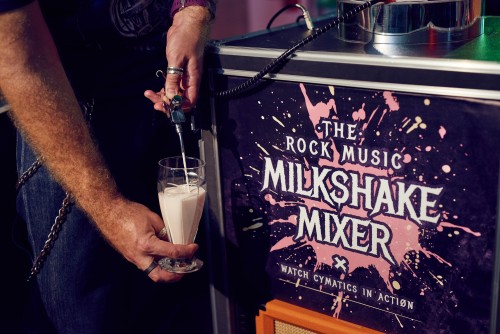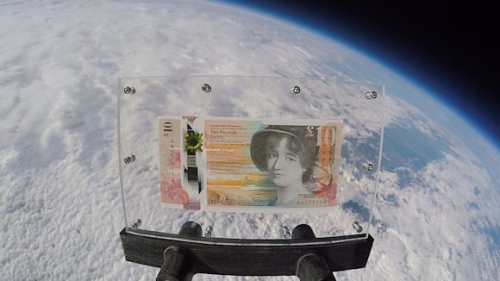Category Archives: The Red Folder
Star Wars fact or fiction, Wikipedia editor in space, stellarator tour
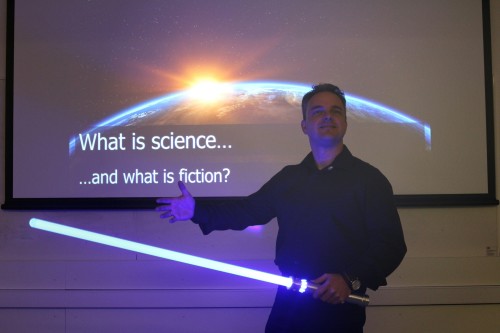
Fact and fiction: Carsten Welsch. (Courtesy: Cockcroft Institute)
By Hamish Johnston
What is it about Star Wars that captivates the imaginations of physicists? Earlier this week Carsten Welsch, who is head of physics at the University of Liverpool and head of communication for the nearby Cockcroft Institute, gave a presentation called “Physics of Star Wars” to an audience of hundreds of secondary school children, undergraduate and PhD students and university staff.
View all posts by this author | View this author's profile
CMS publishes 700 papers, extreme data centres, flat-Earth space programme launches tomorrow

Big data: analysis of CMS papers. See Rao’s article for an interactive version (Courtesy: Achintya Rao/CMS)
By Hamish Johnston
CERN’s CMS collaboration has passed a milestone of sorts at the end of October – it published its 700th research paper. And physicists working on the giant detector on the Large Hadron Collider haven’t stopped there as the tally is now 712 and rising.
CERN’s Achintya Rao has delved into the CMS archives and has chosen his top seven papers. These include the first-ever paper about the detector, which was published in 2008 and, embarrassingly, gets the weight of the detector wrong. Rao has also put together an interactive infographic that looks at 680 papers that analyse data collected by CMS.
View all posts by this author | View this author's profile
Meteoroid seen from space, Nobel laureates speak their minds on group awards and keeping up with technology
By Hamish Johnston
Fix your eyes on the upper-right portion of the above video and pay particular attention about seven seconds into the footage. You will see a fireball falling through Earth’s atmosphere. The video was taken from the International Space Station by the Italian astronaut and prolific photographer Paolo Nespoli.
Was the fireball a piece of space junk, or perhaps a tiny piece of asteroid? And how fast was it moving? For an analysis of what Nespoli may have seen, go to: “The backstory: Paolo spots a meteoroid from the ISS”. There you will also find a fantastic gallery of photographs taken by Nespoli.
View all posts by this author | View this author's profile
Name a distant world, fireworks through a diffraction grating, radio telescope helps Puerto Rican relief
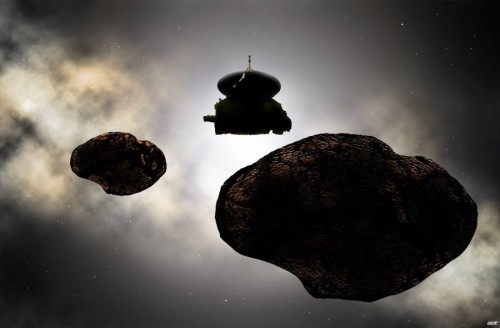
Double act: artist’s impression of the (486958) 2014 MU69 flyby. (Courtesy: NASA/Johns Hopkins University Applied Physics Laboratory/Southwest Research Institute/Carlos Hernandez)
By Hamish Johnston
Here is an opportunity to put your mark on the solar system. NASA and the team behind the New Horizons spacecraft are asking the public to nickname the mission’s next flyby target. Located in the Kuiper belt and called “(486958) 2014 MU69”, the target is likely to be two objects – each about 20 km across – in a very close orbit. So, a name like “Cheech and Chong” could be a winner. To enter, go to “Help us nickname a distant world”.
View all posts by this author | View this author's profile
Putting a stamp on gravitational waves, LEGO’s Women of Nasa, physicist competes in bake-off

Cosmic delivery: German stamp commemorates gravitational waves. (Courtesy: German Federal Ministry of Finance)
By Michael Banks and Hamish Johnston
For those wanting to add a physics twist to your season’s greetings, you now can thanks to Germany’s Federal Ministry of Finance. It has announced two new stamps that will go on sale in the country on 7 December. A €0.40 stamp will feature the European Space Agency’s Gaia satellite and will be the first German stamp to include a metallic coating. Gaia was launched in 2013 to measure the positions and distances of astronomical objects, including stars, planets as well as comets. The ministry also announced a €0.70 stamp that depicts the gravitational waves that emerge from the collision of two black holes. The simulation was made by researchers at the Albert Einstein Institute (AEI) in Potsdam, Germany. “The ministry did not announce whether letters equipped with the new gravitational-wave stamp will be transported at the speed of light,” states an AEI press release.
View all posts by this author | View this author's profile
Hawking’s PhD thesis, Einstein letter up for auction, first zero
By Michael Banks

Courtesy: University of Cambridge
The PhD thesis of the University of Cambridge physicist Stephen Hawking was made freely available to read this week by the university’s Library’s Office of Scholarly Communication.
Hawking completed his PhD – entitled “Properties of expanding universes” – in 1966 when he was 24 years old. To mark Open Access Week 2017, the 117-page tome was posted on the university’s Apollo open-access repository, which is already home to some 15,000 research articles and 2400 theses.
Yet within hours of Hawking’s opus being posted online, demand was so great that the site crashed. However, according to the university, it was still downloaded more than 60,000 times in the first 24 hours.
“By making my PhD thesis open access, I hope to inspire people around the world to look up at the stars and not down at their feet,” Hawking noted. “Anyone, anywhere in the world should have free, unhindered access to not just my research, but to research of every great and enquiring mind across the spectrum of human understanding.”
View all posts by this author | View this author's profile
A rockin’ good milkshake, a telescope that wants to be the next Taj Mahal
By Matin Durrani and Hamish Johnston
Film fans will well remember the opening scene from Back to the Future, in which Marty McFly (played by Michael J Fox) is thrown across a room by a massive sound wave from an enormous guitar amp. It’s more science fiction than science fact, but to illustrate the impact that sound can have on everyday life, staff at EngineeringUK have come up with something really rather clever. To drum up interest in next year’s science-careers show The Big Bang Fair, which is to be held in March in Birmingham, UK, they’ve built what they dub a “Rock Music Milkshake Mixer”.
View all posts by this author | View this author's profile
A tenner in space, why just 0.3% of LIGO bagged the Nobel, sounding-off in Havana
By Hamish Johnston and Matin Durrani
Primary school children in Scotland have celebrated the launch of a new £10 note by launching it into space. Well, sort of. The Royal Bank of Scotland note was actually sent aloft on a high-altitude balloon with a camera to capture the event for posterity.
If you know your astronomers, you will recognize Mary Sommerville on the tenner. She was active in the early 19th century and famously predicted the existence of Neptune by its influence on the orbit of Uranus. She and Caroline Herschel were the first women to be members of the Royal Astronomical Society and she also wrote the bestselling science book On the Connexion of the Physical Sciences.
There is much more about Sommerville in our podcast “Mary, Queen of Scottish banknotes“.
View all posts by this author | View this author's profile
Great wrong theories, new spin on golf, physics photo competition
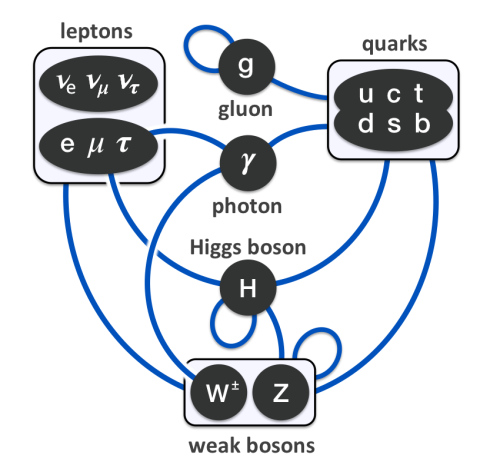
The Standard Model: wrong, but wonderfully wrong (Courtesy: Eric Drexler)
By Hamish Johnston
What is the greatest wrong theory in physics? Physicist Chad Orzel asks that question in his latest blog for Forbes and by wrong he does not mean incorrect, but rather incomplete. He makes the argument for the Standard Model, which he says has been wrong for a very long time – but continues to be phenomenally successful.
View all posts by this author | View this author's profile
Reminiscing about Fermilab, CAPTCHA tests your physics, science of guitar strings
By Hamish Johnston
What do huge snowstorms, pioneering childcare and bison have in common? The answer is that they all feature in video recollections of Fermilab, the particle physics facility that is celebrating its 50th anniversary this year. A playlist of the videos is available and you can watch Cindy Joe’s musings over Snowpocalypse 2011 above.
According to physics blogger ZapperZ, the online retailer Amazon is developing a new CAPTCHA technology that relies on human’s innate understanding of the laws of physics. The idea, apparently, is that a user would be presented with before and after scenarios and asked which seem plausible. This could be a ball rolling down a ramp, or a projectile flying through the air. It seems that web robots can’t solve simple mechanics problems – at least for now.
Ending on a bright note, music technologist and erstwhile physicist Jonathan Kemp of the University of St Andrew’s in Scotland claims to have invented a revolutionary type of guitar string. He riffs on his new creation in the video above.
View all posts by this author | View this author's profile
